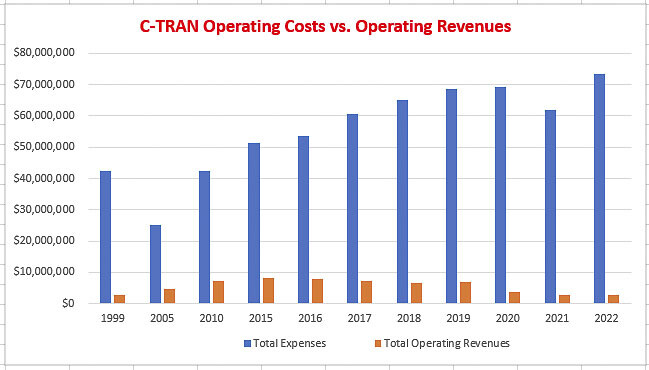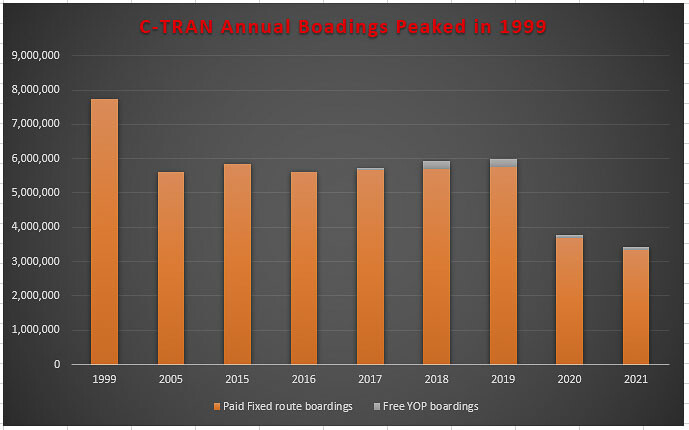Operating revenue per passenger declined from 76 cents in 2021 to 61 cents in 2022; the agency plans a fare increase in 2024
John Ley
for Clark County Today
The three years of the government lockdowns were devastating to transit agencies around the nation, including Clark County’s C-TRAN. Yet 2022 showed an increase in fixed route ridership but a decline in operating revenue per passenger. C-TRAN’s annual financial report was released in late June.
For each hour a bus is in revenue service, C-TRAN carried 14.5 passengers, up from 12.2 passengers in 2021. Operating revenue per passenger declined from 76 cents in 2021 to 61 cents in 2022. The agency plans a fare increase in 2024 to reverse that trend.
The balance sheet increased by $65 million in 2022. Over the three years of the pandemic, the balance sheet increased by $150 million. A significant part of that cash increase came from the federal government.The transit agency remains free of long term debt.
“C-TRAN was assisted by Federal Stimulus Funding through CARES, CRRSAA and ARP acts that were provided to all agencies in the United States to assist during the pandemic,” C-TRAN officials said in a public records request response. “Some additional factors that impacted the increase in net position was our planned service changes that we built into the budget in 2020-2021, which we put on hold. Those increases have begun to be implemented over the past two years (2022-2023) with more to come in 2024.
“That Federal assistance has not been extended, and it is uncertain if they will take any such action going forward. Other factors influencing the Net Position include growth in the agency’s sales tax revenue, interest income, other ongoing federal and state assistance, as well as one-time grant funding received for capital projects (i.e. capital contributions).”

The Operating Cost Per Revenue Hour increased 15 percent as a result of the 3.0 percent drop in revenue hours and an 11.7 percent increase in operating cost. Each hour a bus is in service costs C-TRAN $180.57, while it brings in $8.84 carrying those 14.5 passengers.
Passenger fares cover 5 percent of operating costs. The farebox recovery ratio is 4.9 percent, meaning Clark County taxpayers cover over 95 percent of C-TRAN operating costs, mainly via sales taxes.
Overall, C-TRAN ridership remains about 36 percent below prepandemic levels. The agency’s transit development plan published last fall indicated C-TRAN officials don’t expect ridership to return to 2019 levels until after 2027.
A small bright spot for the transit agency is its demand transit service, C-TRAN increased service overby 50 percent or 33,000 hours last year. This was primarily due to the creation of a new “micro transit.”
The new service, The Current, began last year. Think Uber or Lyft type of on-demand service in five distinct areas. Those areas are WSU Vancouver/Salmon Creek; Rose Village; Camas/Washougal; and the Port of Vancouver.
Total on demand service carried an additional 61,000 people in 2022, but remains 30 percent below 2019 pre pandemic levels. The Current carries 1.4 boardings per revenue hour. The two most utilized “zones” are Camas/Washougal and Salmon Creek/WSUV (especially when classes are in session), according to C-TRAN.
C-TRAN does not separate The Current costs but includes them in the agency’s total demand response spending. The cost per operating hour in Demand Response is $167.13 per hour. “While ridership in paratransit encompasses less than 5 percent of our total ridership, the expenditures are approximately 20-25% of total operating costs,” they said.
Total system ridership remains 2.2 million below pre-pandemic levels of about 6 million annual boardings. During the pandemic, the agency experienced one of the smallest declines in ridership among Washington transit agencies C-TRAN ridership peaked at 7.75 million annual boardings in 1999.

Through the first six months of 2023, C-TRAN has experienced a ridership increase of over 400,000 at an average rate of over 21 percent compared to 2022. A portion of this increase is due to the state making transit ridership free for youth 18 and under last year. “Ridership is impacted by several factors, such as moves back to in-person schooling and work settings, as well as opportunities to increase service as we are doing now,” they said.
The number of buses in the C-TRAN fleet was 123 in 2020, and has been reduced to 106 in 2022.
C-TRAN provides the only cross-river transit service over the Columbia River. This is keenly of interest to Clark County citizens as the Interstate Bridge Replacement (IBR) program is predicting 26,000 to 33,000 boardings on the I-5 corridor by 2045.
Express Routes crossing the I-5 bridge saw an average of 523 daily boardings in 2022.
Express Routes crossing the I-205 bridge saw an average of 273 daily boardings.
Note that these numbers include Express only, as requested, and does not include Regional routes that also cross the Columbia River.
In October, C-TRAN expects to open its second $50 million Bus Rapid Transit system. It will run from Clark College in east Vancouver to downtown, on Mill Plain.
Also read:
- Belkot speaks before C-TRAN board; directors pause vote on light rail funding language until JulyMichelle Belkot spoke at Tuesday’s C-TRAN board meeting, calling her removal from the board unlawful; directors postponed a vote on light rail funding language until July amid legal challenges.
- Travel Advisory: Expect delays on northbound I-5 near RidgefieldWSDOT is warning travelers to expect delays near Exit 14 on northbound I-5 in Ridgefield as crews begin barrier and lane improvement work supporting future development.
- Large crowd expected at C-TRAN Board of Directors Meeting Tuesday, April 15A large turnout is expected at the April 15 C-TRAN board meeting, where public input and a key vote on light rail funding will follow the recent removal of Michelle Belkot.
- Letter: ‘The IBR needs a more cost-effective design’Bob Ortblad argues the I-5 Bridge replacement project is overbudget and inefficient, urging a more cost-effective tunnel alternative to avoid excessive tolls and taxpayer burden.
- Clark County beginning installation of upgraded traffic signals in mid-AprilClark County will begin upgrading multiple traffic and pedestrian signals in mid-April to improve safety, accessibility, and transportation technology.










So…less riders, with those riders funding less of the costs, while C-Tran will spend $50 million on a new Bus Rapid Transit system to carry fewer riders and who aren’t paying nearly their share. Does this make sense to anyone?? WHY do we keep funding this boondoggle??
When the CTRAN Board decided to use 60′ long articulated buses on Mill Plain for the Bus Rapid Transit system, vs. the prior 40′ buses previously used, I objected to the board because the ridership numbers did not justify much larger vehicles. Since then , ridership has fallen, but plans to buy bigger buses and tear up Mill Plain for bigger bus stops for a few riders went full steam ahead.
In about 2004 or 2005, CTRAN passed a sales tax hike. At the time, they stated that the public asked, and CTRAN delivered smaller buses, since it was apparent that the 40′ buses were not very full, wasting fuel and polluting.
Today, in spite of low ridership, CTRAN is spending so many taxpayer $ on bigger buses for fewer riders. And they are planning for an electric bus fleet, in spite of problems with spontaneous combustion of electric buses.
https://www.fox61.com/article/news/local/cttransit-electric-bus-fleet-pulled-stop-operation-fire/520-ab9a5403-ba49-40db-9877-75e312fb7bce